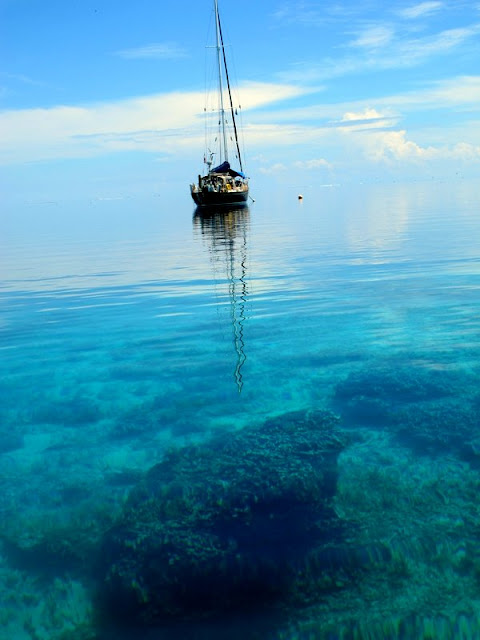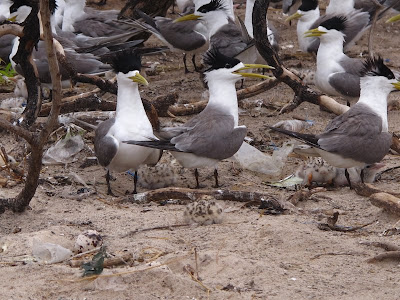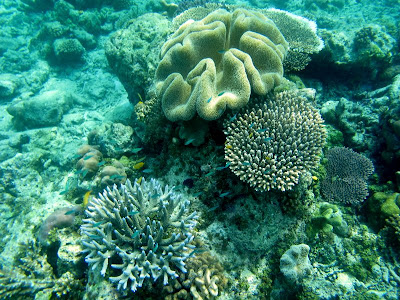Helen Reef
Craziest thing. Helen Reef maybe gets 4 or 5 visiting yachts
per year and we show up on the morning with another yacht arriving from the
opposite direction. The caretakers
came down to the opening to lead us through the maze of reefs and up to Helen
Island where we anchored. Good thing,
as our charts did not accurately reflect the reefs here at all. The other yacht, a mega yacht, anchored
outside of the lagoon while we were lead inside to a mooring. Fine, we thought. Nice, calm, peaceful. For two days, then all hell broke
loose. The SW monsoon regularly breeds
super squalls and we got 3 of them over two days. We were up all night for two nights,
fighting boarding waves, dragging on the mooring, which we finally dropped just
before hitting the reef, and then the next night dragging on our own
anchor. The squalls were like pit
bulls on acid, ferocious, packing 50 knots in front of them. Jim and I both thought for awhile we were
going to lose the boat on the reefs.
Unlike me, Jim is skilled and keeps his head during these things. While I was screaming as loud as the
squalls, Jim managed to get us re-anchored in unimaginable conditions.
Other than that, Helen Reef was an amazing stop. The caretakers, Hercules, Frano and Petra,
were very welcoming and invited us ashore to see the turtles laying their eggs
and be a part of the releasing of the babies.
They came by the boat with gifts of fish and lobster and pointed out the
best snorkeling spots. Every time we went in the dinghy we saw
turtles and rays swimming in front of us.
Three types of birds call the tiny island home and there are thousands of them with hundreds of fresh hatchlings every day.
Turtles come in every night to lay their eggs and dozens of baby turtles are picked up by the park rangers every night to be protected and then released when they are able.
The island is small and getting smaller. It has moved east over the past 10 years and according to one of the caretakers, Frano, who has come here a lot over the last 20 years, the island is only 1/4 of its original size and he predicts it will be gone in 10 more years.
Here's some more underwater shots I took while snorkeling. I'm using a Canon G12 with a housing. It's a great camera and highly recommend it.
Cruising notes: DO NOT GO HERE WHEN THERE IS A LOW PRESSURE SYSTEM ABOVE PALAU!!!!!!! Anchorage ((02 52.504N; 131 43.841E (entrance))(02 57.9N; 131 48.5E (mooring). There is room to anchor in sand rather than take the mooring. Beautiful spot and can swim to snorkel on at least 3 reef sections. Walking around the island is great and you can watch the turtles being released or stay into the night to watch the big turtles come ashore to lay their eggs. Caretakers welcome visitors and appreciate any gifts. We left them a bunch of DVDs.
Three types of birds call the tiny island home and there are thousands of them with hundreds of fresh hatchlings every day.
Turtles come in every night to lay their eggs and dozens of baby turtles are picked up by the park rangers every night to be protected and then released when they are able.
The island is small and getting smaller. It has moved east over the past 10 years and according to one of the caretakers, Frano, who has come here a lot over the last 20 years, the island is only 1/4 of its original size and he predicts it will be gone in 10 more years.
Here's some more underwater shots I took while snorkeling. I'm using a Canon G12 with a housing. It's a great camera and highly recommend it.
Cruising notes: DO NOT GO HERE WHEN THERE IS A LOW PRESSURE SYSTEM ABOVE PALAU!!!!!!! Anchorage ((02 52.504N; 131 43.841E (entrance))(02 57.9N; 131 48.5E (mooring). There is room to anchor in sand rather than take the mooring. Beautiful spot and can swim to snorkel on at least 3 reef sections. Walking around the island is great and you can watch the turtles being released or stay into the night to watch the big turtles come ashore to lay their eggs. Caretakers welcome visitors and appreciate any gifts. We left them a bunch of DVDs.































































